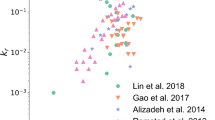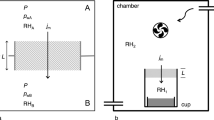Abstract
The sorptivity is used widely to characterise water dynamics in construction materials. Yet its variation with temperature has been little investigated. We report the results of a collaborative study between two laboratories in which the temperature dependence of the sorptivity of ten materials has been measured in part or all of the range 5–45 °C. The materials cover a wide range of compositions and of numerical sorptivity values. We find that the sorptivity is about 50% greater at 45 °C than at 5 °C, and that, with one exception, the temperature coefficient is similar in all the materials studied. This shows that for practical purposes the value of the sorptivity of an individual material at any temperature in this range may be estimated from a single measured value. The observed variation with temperature is attributed to the changes in the viscosity and surface tension of water, and is as predicted by a simple classical scaling of capillary dynamics, assuming that neither the wetting index nor the capillary moisture content vary with temperature. One of the materials studied, Lympia chalk, shows a somewhat smaller temperature variation than predicted by this scaling. We comment that commonly-used standards do not recognise adequately that the sorptivity varies with temperature.










Similar content being viewed by others
References
Bentz DP, Ehlen MA, Ferraris CF, Winpegler JA (2002) Service life prediction based on sorptivity for highway concrete exposed to sulfate attack and freeze-thaw conditions. Federal Highway Administration Report FHWA-RD-01-162, U.S. Department of Transportation, McLean, VA
Weiss WJ (2014) Relating transport properties to performance in concrete pavements. The Long-Term Plan for Concrete Pavement Research and Technology (CP Roadmap)
Kurtis K, Burris L, Alapati P (2016) Consider functional equivalence: a (faster) path to upscaling sustainable infrastructure materials compositions. In: First international conference on grand challenges in construction materials, Los Angeles
Hall C, Hoff WD (2007) Rising damp: capillary rise dynamics in walls. Proc R Soc A 463:1871–1884
Hall C, Hoff WD (2012) Water transport in brick, stone and concrete, 2nd edn. Taylor & Francis, London
Gummerson RJ, Hall C, Hoff WD (1980) Water movement in porous building materials—II. Hydraulic suction and sorptivity of brick and other masonry materials. Build Environ 15:101–108
Ioannou I, Hoff WD, Hall C (2004) On the role of organic adlayers in the anomalous water sorptivity of Lépine limestone. J Colloid Interface Sci 279:228–234
Feng C, Janssen H (2016) Hygric properties of porous building materials (II): analysis of temperature influence. Build Environ 99:107–118
Karagiannis N, Karoglou M, Bakolas A, Moropoulou A (2016) Effect of temperature on water capillary rise coefficient of building materials. Build Environ 106:402–408
Karagiannis N, Karoglou M, Bakolas A, Moropoulou A (2016) Building materials capillary rise coefficient: Concepts, determination and parameters involved. In: Delgado JMPQ (ed) New approaches to building pathology and durability, Building Pathology and Rehabilitation no 6. Springer, Singapore, pp 27–44
Feng C, Janssen H (2017) The influence of temperature on the capillary absorption coefficient—a confrontation of two recent papers in building and environment. Build Environ. doi:10.1016/j.buildenv.2016.11.049
Reinhardt H-W, Jooss M (1998) Permeability, diffusion and capillary absorption at elevated temperature in the service range. Otto Graf J 9:34–47
Guizzardi M, Derome D, Carmeliet J (2014) Water uptake in clay brick at different temperatures: experiments and numerical simulations. J Build Phys 39:373–389
Washburn EW (1921) The dynamics of capillary flow. Phys Rev 18:273–283
Lucas R (1918) Über das Zeitgesetz des kapillaren Aufstiegs von Flüssigkeiten. Kolloid Z 23:15–22
Philip JR, de Vries DA (1957) Moisture movement in porous materials under temperature gradients. Trans Am Geophys Union 38:222–232
Hall C (1989) The water sorptivity of mortars and concretes: a review. Mag Concr Res 41:51–61
Philip JR (1957) The theory of infiltration. 1. The infiltration equation and its solution. Soil Sci 83:345–357
Culligan PJ, Ivanov V, Germaine JT (2005) Sorptivity and liquid infiltration into dry soil. Adv Water Resour 28:1010–1020
Roels S, Carmeliet J, Hens H, Adan O, Brocken H, Cerny R, Pavlik Z, Kumaran K, Hall C, Pel L, Plagge R (2004) Inter laboratory comparison of the hygric properties of porous building materials. J Therm Envel Build Sci 27:307–325
Tanaka M, Girard G, Davis R, Peuto A, Bignell N (2001) Recommended table for the density of water between 0 \(^\circ\)C and 40 \(^\circ\)C based on recent experimental reports. Metrologia 38:301–309
Pátek J, Hrubý J, Klomfar J, Součková M, Harvey AH (2009) Reference correlations for thermophysical properties of liquid water at 0.1 MPa. J Phys Chem Ref Data 38:21–29
IAPWS (2014) Revised release on surface tension of ordinary water substance, Moscow
IAPWS (2008) Release on the IAPWS Formulation 2008 for the viscosity of ordinary water substance, Berlin
Huber ML, Perkins RA, Laesecke A, Friend DG, Sengers JV, Assael MJ, Metaxa IN, Vogel E, Mare R, Miyagawa K (2009) New international formulation for the viscosity of H\(_2\)O. J Phys Chem Ref Data 38:101–125
Modestou S, Theodoridou M, Fournari R, Ioannou I (2016) Physico-mechanical properties and durability performance of natural building and decorative carbonate stones from Cyprus. In: Přikiryl R, Török Á, Gomez-Heras M, Miskovsky K, Theodoridou M (eds) Sustainable use of traditional geomaterials in construction practice, Special Publications, vol 416. Geological Society, London, pp 145–162
Hamilton A, Hall C (2007) A note on the density of a calcium silicate board material. J Build Phys 31:69–71
Hall C, Hamilton A (2015) Porosity–density relations in brick and stone materials. Mater Struct 48:1265–1271
Bachmann J, van der Ploeg RP (2002) A review on recent developments in soil water retention theory: interfacial tension and temperature effects. J Plant Nutr Soil Sci 165:468–478
Grant SA, Salehzadeh A (1996) Calculation of temperature effects on wetting coefficients of porous solids and their capillary pressure functions. Water Resour Res 32:261–270
Grant SA (2003) Extension of a temperature effects model for capillary pressure saturation relations. Water Resour Res. doi:10.1029/2000WR000193
ASTM C1585-13 Standard test method for measurement of rate of absorption of water by hydraulic-cement concretes. ASTM International, West Conshohocken
BS EN 1925:1999 Natural stone test methods—determination of water absorption coefficient by capillarity. British Standards Institution, London
BS EN ISO 15148:2002 Hygrothermal performance of building materials and products—determination of water absorption coefficient. British Standards Institution, London
Acknowledgements
We thank Professor W. D. Hoff for his comments. We also wish here to recognise his lifelong contributions to water transport studies. CH acknowledges the use of the Stapleford laboratory.
Author information
Authors and Affiliations
Corresponding author
Ethics declarations
Conflict of interest
The authors declare that they have no conflict of interest.
Rights and permissions
About this article
Cite this article
Ioannou, I., Charalambous, C. & Hall, C. The temperature variation of the water sorptivity of construction materials. Mater Struct 50, 208 (2017). https://doi.org/10.1617/s11527-017-1079-6
Received:
Accepted:
Published:
DOI: https://doi.org/10.1617/s11527-017-1079-6




